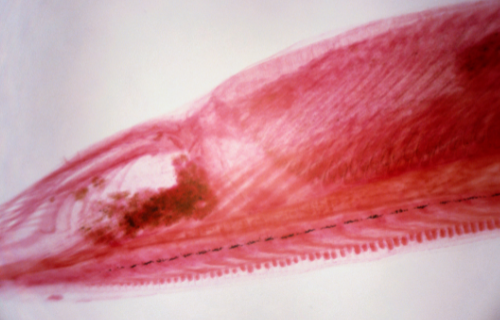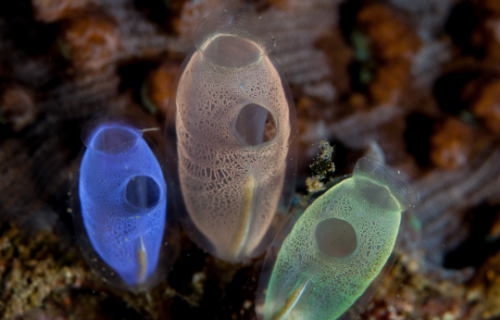Difference Between Lancelets and Tunicates
Both lancelets and tunicates are chordates; these filter feeders are the only invertebrates within the phylum Chordata which consists of animals with flexible rods that support their backs. Specifically, lancelets belong to the subphylum Cephalochordata while tunicates belong to the subphylum Urochordata (University of Hawai’i, 2022). Their distinctions are discussed below.

What are Lancelets?
Lancelets are also called “amphioxus” which means “both ends pointed” (CK-12, 2016). They are also known as cephalochordates because their notochords (flexible rod of cells that support their bodies) extend from their tails into their body anterior (Ghiselin, 2008). They are small, eel-like filter feeders that live in the ocean. These slender fish-like chordates do not have eyes and are one to eight centimeters long; they are whitish to creamy yellow, sometimes with a tint of pink. Their pearly sheen is caused by the mucus secreted by the cells in their body covering (Encyclopedia.com, 2019).
Lancelets have no brains and hearts, but they have nerve cords and blood vessels (Wildlife Journal Junior, 2022); they run along the top of their notochords. Different types of sensing cells are distributed in a lancelet’s body covering, particularly near the snout. The chest has around 200 gill slits that empty into a chamber inside the body (the gills do not open to the outside); the chamber empties through a hole on the belly (Encyclopedia.com, 2019).
They live in all oceans; lancelets live in sandy bottoms near the shore. Unlike other tunicates (marine invertebrate animals), they can swim; however, they usually stay buried in sandy, shallow regions (CK-12, 2016). They anchor their tails in the sand and let the water wash over their mouths; they use their cilia (short, hair-like filaments) to filter out food such as plankton and diatoms (Encyclopedia.com, 2019).

What are Tunicates?
“Tunicates” came from the Latin word “tunicare” which translates to “clothe with a tunic”. Their flexible outer covering is called a tunic, it protects them from predators. Since they shoot out water when touched or alarmed, the most common tunicates are sometimes called “sea squirts” (Smithsonian, 2018).
Tunicates often appear as small colored blobs and are usually seen attached to rocks, docks, or boats’ undersides. They can be found in both shallow and deep water, in most marine habitats (Holland, 2016). Most of them live with their posteriors firmly attached to fixed objects.
Their bodies have two siphons or openings. They draw seawater through the oral siphon, the water passes through the branchial basket (a sieve-like structure) which traps food (i.e., plankton) and oxygen, the water is then expelled via the atrial siphon ([What’s a Tunicate], n.d.).
Difference between Lancelets and Tunicates
Definition
Lancelets are also called “amphioxus” which means “both ends pointed” (CK-12, 2016). They are also known as cephalochordates because their notochords (flexible rod of cells that support their bodies) extend from their tails into their body anterior (Ghiselin, 2008), to the head region (Lakna, 2018). They are small, eel-like filter feeders that usually stay buried (although they can swim) in sandy, shallow marine regions. In comparison, “tunicates” came from the Latin word “tunicare” which translates to “clothe with a tunic”. Their flexible outer covering is called a tunic, it protects them from predators. These marine invertebrates are usually seen attached to rocks, docks, or boats’ undersides. Since they shoot out water when touched or alarmed, the most common tunicates are sometimes called “sea squirts” (Smithsonian, 2018; Lakna, 2019).
Features
Lancelets are slender fish-like chordates that do not have eyes, brains, and hearts and are 1 to 8 centimeters long; they are whitish to creamy yellow, sometimes with a tint of pink. These blade-shaped animals have a pearly sheen caused by the mucus secreted by the cells in their body covering. Different types of sensing cells are distributed in a lancelet’s body covering, the chest has around 200 gill slits that empty into a chamber inside the body (Encyclopedia.com, 2019; Wildlife Journal Junior, 2022). On the other hand, some of their features include being barrel-shaped, often appearing as small colored blobs, and having two siphons or openings. They draw seawater through the oral siphon, the water passes through the branchial basket (a sieve-like structure) which traps food and oxygen, the water is then expelled via the atrial siphon ([What’s a Tunicate], n.d.; Holland, 2016).
Subphylum
Lancelets belong to the subphylum Cephalochordata (notochord extended to the head region) while tunicates belong to the subphylum Urochordata (notochord in the posterior part of the body; University of Hawai’i, 2022)
Lancelets vs Tunicates

Frequently Asked Questions:
How are vertebrates distinguished from tunicates and lancelets?
Tunicates and lancelets do not have backbones (Boundless, 2021) while vertebrates have backbones.
How are tunicates and lancelets similar?
Both are small and primitive marine organisms (CK-12, 2021); they belong to the phylum Chordata and feed on planktons.
What do lancelets have that tunicates lack?
Lancelets have a distinct coelom or body cavity which forms a system of cavities and spaces (Ghiselin, 2008). On the other hand, tunicates do not develop a very distinct body coelom. Moreover, lancelets have a segmented body while tunicates lack myomeric segmentation. Also, lancelets’ excretory systems contain segmented kidneys with protonephridia while tunicates lack kidney-like metanephridial organs (Lakna, 2019).
Summary
- Both lancelets and tunicates are chordates; these filter feeders are the only invertebrates within the phylum Chordata which consists of animals with flexible rods that support their backs.
- Lancelets belong to the subphylum Cephalochordata while tunicates belong to the subphylum Urochordata
- Lancelets are slender and fish-like; they do not have eyes, brains, or hearts and are 1 to 8 centimeters long; they are whitish to creamy yellow, sometimes with a tint of pink. On the other hand, tunicates are barrel-shaped, often appearing as small colored blobs, and have two siphons or openings.
- Difference Between Hematoma and Melanoma - February 9, 2023
- Difference Between Bruising and Necrosis - February 8, 2023
- Difference Between Brain Hematoma and Brain Hemorrhage - February 8, 2023
Search DifferenceBetween.net :
Leave a Response
References :
[0]Boundless. (2020). Chordates and evolution of vertebrates. LibreTexts. https://bio.libretexts.org/Bookshelves/Introductory_and_General_Biology/Book%3A_General_Biology_(Boundless)/29%3A_Vertebrates/29.1%3A_Chordates/29.1B%3A_Chordates_and_the_Evolution_of_Vertebrates
[1]CK-12. (2016). Lancelets. https://www.ck12.org/book/ck-12-biology-advanced-concepts/section/15.48/
[2]Ghiselin, M. T. (2008, October 23). cephalochordate. Encyclopedia Britannica. https://www.britannica.com/animal/cephalochordate
[3]Smithsonian (2018). Tunicates- Not so spineless invertebrates. https://ocean.si.edu/ocean-life/invertebrates/tunicates-not-so-spineless-invertebrates#:~:text=The%20most%20common%20tunicates%20are,in%20the%20animal%20shoots%20out.
[4]Wildlife Journal Junior (2022). Cephalochordata. https://nhpbs.org/wild/lancelets.asp
